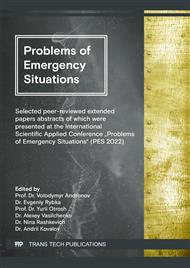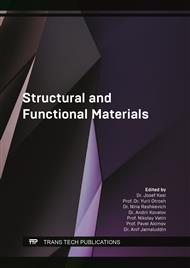[1]
Joseph R., Surface Hardening of Steels: Understanding the Basics. Publisher: ASM International. (2002). 364.
Google Scholar
[2]
Wang Z.B., Tao N.R., Li S., Wang W., Liu G., Lu J., Lu K. Effect of surface nanocrystallization on friction and wear properties in low carbon steel. Materials science and engineering, A 352 (1–2) (2003) 144–149.
DOI: 10.1016/s0921-5093(02)00870-5
Google Scholar
[3]
Lu K., Lu. J. Nanostructured surface layer on metallic materials induced by surface mechanical attrition treatment. Materials science and engineering, A 375–377 (2004) 38–45.
DOI: 10.1016/j.msea.2003.10.261
Google Scholar
[4]
Ba D.M., Ma S.N., Meng F.J., Li C.Q. Friction and wear behaviors of nanocrystalline surface layer of chrome-silicon alloy steel. Surface and coatings technology, 202 (2) (2007) 254–260.
DOI: 10.1016/j.surfcoat.2007.05.033
Google Scholar
[5]
Xu Y.H., Peng J.H., Fang L. Nano-crystallization of steel wire and its wear behavior. Materials Science and Engineering, A. 483–484 (2008) 688–691.
DOI: 10.1016/j.msea.2006.09.190
Google Scholar
[6]
Zhou L., Liu G., Han Z., Lu K. Grain size effect on wear resistance of a nanostructured AISI52100 steel. Scripta materialia, 58 (6) (2008) 445–448.
DOI: 10.1016/j.scriptamat.2007.10.034
Google Scholar
[7]
Lv X.R., Wang S.G., Liu Y., Long K., Li S., Zhang Z.D. Effect of nanocrystallization on tribological behaviors of ingot iron. Wear, 264 (7–8) (2008) 535–541.
DOI: 10.1016/j.wear.2007.04.010
Google Scholar
[8]
Galvao I., Leal R.M. Loureiro A.. Influence of tool shoulder geometry on properties of friction stir welds thin copper sheets. Journal of materials processing technology, 213 (2) (2013) 129–135.
DOI: 10.1016/j.jmatprotec.2012.09.016
Google Scholar
[9]
Chernukha A.A., Сhernukha A.N., Ostapov K., Kurska T. Investigation of the Processes of Formation of a Fire Retardant Coating. Materials Science Forum, 1038 (2021) 480–485.
DOI: 10.4028/www.scientific.net/msf.1038.480
Google Scholar
[10]
Rajamanickam N., Balusamy V., Magudeeswaran G., Natarajan K. Effect of process parameters on thermal history and mechanical properties of friction stir welds. Materials & Design, 30 (7) (2009) 2726–2731.
DOI: 10.1016/j.matdes.2008.09.035
Google Scholar
[11]
Momeni A., Arabi H., Rezaei A., Badri H., Abbasi S.M. Hot deformation behavior of austenite in HSLA-100 microalloyed steel. Materials Science and Engineering, A 528 (4–5) 25 (2011) 2158–2163.
DOI: 10.1016/j.msea.2010.11.062
Google Scholar
[12]
Sipos K., Lopez M., Trucco M. Surface martensite white layer produced by adhesive sliding wear friction in AISI 1065 steel. Revista latinoamericana de metalurgia y materiales, 28 (1) (2008) 46–50.
Google Scholar
[13]
Yan W., Fang L., Sun K., Xu Y. Effect of surface work hardening on wear behavior of Hadfield steel. Materials science and engineering, A 460–461 (2007) 542–549.
DOI: 10.1016/j.msea.2007.02.094
Google Scholar
[14]
Volkov О.А. Study of heat deformation influence in surface strain hardening of steel by thermofriction processing. Eastern-European journal of enterprise technologies, 2 5(80) (2016) 38–44.
DOI: 10.15587/1729-4061.2016.65458
Google Scholar
[15]
Volkov O., Knyazev S., Vasilchenko A., Doronin E. Alternative Strengthening of Jewelry Tools Using Chemical-Thermal and Local Surface Treatments. Materials Science Forum, 1038 (2021) 68-76.
DOI: 10.4028/www.scientific.net/msf.1038.68
Google Scholar



